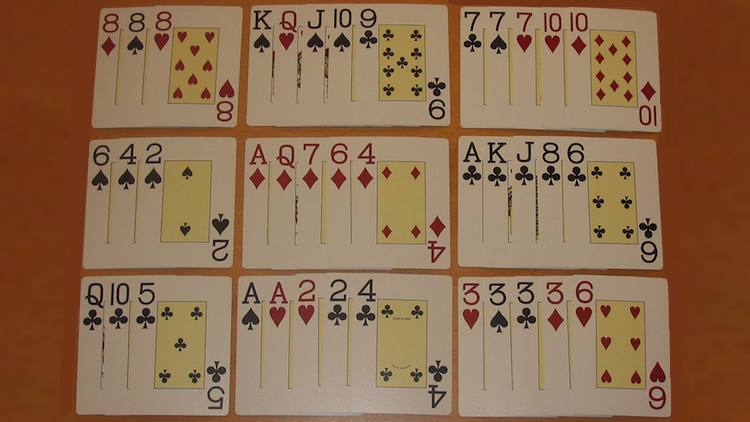Chinese poker is a fun poker variant that has enjoyed a resurgence in popularity over recent years.
During the mid-1990s, Chinese poker was actually featured in bracelet events at the World Series of Poker for a couple of years before being dropped. The game then enjoyed a comeback during the early 2010s. Some might recall Chinese poker being featured at the PokerStars Caribbean Adventure a few years ago.
Chinese poker rules are not that difficult to learn and the game can be very entertaining to play. It has a lot of action when compared to some other poker variants. It can be played either heads-up, or with three or four players.
Here is a quick guide explaining how to play Chinese poker and a few strategy tips for new players.
Introducing Chinese poker
First off, the game played at the WSOP back in the 1990s was the traditional “closed” version of Chinese poker, which is different from open-face Chinese poker that has become popular more recently.
The traditional version involves players being initially dealt 13 cards each, from which players arrange or “set” three different poker hands — a three-card hand, and two five-card hands. Players then reveal their cards all at once, and the hands are compared in order to determine how points are awarded.
In open-face Chinese poker players are only dealt five cards to begin, and then are dealt one card at a time thereafter, totaling 13. However they have to “set” their three poker hands as they go, starting with the first five cards and then adding one card at a time after each new card is dealt to them.
That presents an added challenge when it comes to arranging their Chinese poker hands. It also increases the chance players might “foul” their hands in the way they set them.
We’re getting ahead of ourselves, though. Let’s back up and explain in more detail just how the game works.
Setting Chinese poker hands
What is meant by “setting” your three poker hands? Look at the photo up above — those are some examples of Chinese poker hands that have already been set. Here’s the first hand in the picture:
8♦ | 8♠ | 8♥
K♠ | Q♥ | J♠ | 10♠ | 9♣
7♣ | 7♠ | 7♥ | 10♥ | 10♦
On the “top” (shown on the left side in the picture) goes the three-card hand. The highest-ranking hand you can make on the top row is three of a kind, followed by a pair, then ace-high, king-high, and so on. You can’t make a straight or flush out of the three-card hand you set up top.
You set five-card hands on both the “middle” and “bottom” rows. The poker hand rankings are just like the regular five-card poker hands we all learned when we first learned how to play poker.
Importantly, when setting your hands in Chinese poker, your weakest or lowest-ranking hand must appear on the top row, your second-strongest hand must appear in the middle, and your strongest or highest-ranking hand must appear on the bottom.
In that first hand up above, the “top” hand is three of a kind, the “middle” one is a king-high straight, and the “bottom” one is a full house (sevens over tens). Those are three strong hands for Chinese poker.
If you fail to set your hands so that the weakest is up top, the strongest is on the bottom, and the middle hand is in between, then you have “fouled” your hand and your opponent “scoops” you. For example, if you have three of a kind on the top row but just a pair in the middle, you’ve fouled your hand.
“Scooping” is explained below, but just know that getting scooped is the worst possible outcome for you — it’s like getting shut out entirely.
The order of play in open-face Chinese poker
In traditional “closed” Chinese poker in which players arrange all 13 cards at once, it is relatively easy to avoid fouling your hand. In fact in that game, fouled hands only ever happen when a player isn’t paying close attention to what he or she is doing when arranging the cards.
In open-face Chinese poker (sometimes called “open faced Chinese poker”), however, you don’t get to set all 13 cards at once, but have to start out with five cards, then add one at a time thereafter until you’ve set all 13. Thus if you don’t plan ahead or aren’t careful, it can be easy to set a better hand in the middle than on the bottom, or one on the top that is better than the one in the middle.
Since you don’t get your 13-card hand dealt to you all at once, you have to gamble a little and try to set better hands on the bottom. However the cards might not agree with you, and thus you never are able to complete that flush you were trying to put on the bottom row (for example).
As far as the order of play is concerned, the poker player designated as the dealer deals out five cards to each player. The player to the left of the dealer then arranges those five cards, setting them face up on empty spots either on the top, middle, or bottom rows.
The player can place the cards any way he or she likes — all five on the bottom, two on the bottom and three in middle, one each on the top and middle and three on the bottom, etc. Moving clockwise, the next player does the same with his or her five cards and so on until the last player does so.
Again, here is how the board is usually arranged, showing the top, middle, and bottom rows:
X | X | X
X | X | X | X | X
X | X | X | X | X
Then following the same order, players are each dealt one card face down, then taking turns each one sets that card in an empty spot somewhere on their boards. NOTE: Once a card is placed on a player’s board, it cannot be moved — whatever row the card has been added to, that’s where it stays.
Eventually everyone is dealt a 13th and final card and with it will have completed the setting of their three hands.
Players are trying to make better hands than their opponents, but they are also trying to be careful not to foul their own hands. It can get tricky!
Now it’s time to figure out who won and work out the scoring.
Scoring in Chinese poker
For scoring purposes, the top rows of players’ hands are compared with each other to see how the hands rank against each other, as are the middle rows and bottom rows.
Look again at the photo up top showing three Chinese poker hands. In that game, the three of a kind is the best “top” hand, the ace-high flush (in the second hand) is the best “middle” one, and the four of a kind (in the third hand) is the best “bottom” hand.
Having the best hand wins you 1 point. That means 3 points are up for grabs in each open-face Chinese poker hand (at least — more on that in a moment). In the example above, each player won a single point for winning one of the rows.
If one player wins all of the rows — top, middle, and bottom — that player gets 6 points (not just 3), 1 point each for winning all 3 hands, plus 3 bonus points. To win all three hands is to “scoop” your opponent. If you are playing heads-up and you foul your hand (as described above), your opponent “scoops” you and gets 6 points.
The scoring doesn’t end there, though. There are still royalties to consider.
Royalties are bonus points players receive by making certain hands on each row. For example, a full house on the bottom row earns an extra 6 points in royalties. Getting three eights on the top row like that player in the first hand up above gets a handsome 16 points in royalties.
Players sometimes add all sorts of tweaks to how royalties are awarded, but here is a traditional breakdown of how they often go in open-face Chinese poker:
Royalties for bottom hand:
Straight: +2
Flush: + 4
Full House: +6
Quads: +10
Straight Flush: +15
Royal Flush: +25
Royalties for middle hand:
Three of a kind: +2
Straight: +4
Flush: + 8
Full House: +12
Four of a kind: +20
Straight Flush: +30
Royal Flush: +50
Royalties for top hand:
66 +1
77 +2
88 +3
99 +4
TT +5
JJ +6
QQ +7
KK +8
AA +9
222 +10
333 +11
444 +12
555 +13
666 +14
777 +15
888 +16
999 +17
TTT +18
JJJ +19
QQQ +20
KKK +21
AAA +22
As you might imagine, royalties can influence strategy quite a bit, adding a lot of interesting “gamble” to the game.
Players typically play open-face Chinese poker for a certain amount of money per point. Say two players are playing at $1 per point. Player A earns 9 points for winning the top and bottom hands plus some royalties, and Player B wins just 1 point for winning the middle hand. Player A is now up 8 points or $8.
Fantasyland in open-face Chinese poker
There are a lot of other variations and twists players add to the game, but we’ll just mention one common one here — Fantasyland.
Fantasyland is a kind of bonus achieved by a player who is able to set a pair of queens or better on the top row without fouling his or her hand. For example, that first hand up above with the three eights up top would “make it to Fantasyland,” so to speak.
The reward for making it to Fantasyland is for that player to get all 13 cards dealt at once at the beginning of the next hand, very much like traditional “closed” Chinese poker. The player then gets to set top, middle, and bottom hands all at once, positioning them face down on the board, while the other players still have to go through the step-by-step setting of their hands.
The player who gets to play “in Fantasyland” obviously has a huge advantage!
Chinese poker strategy tips
That’s a lot to take in at once, we know. But the game is actually not that complicated, once you get the hang of it. Here is some basic poker strategy to help you as you learn how to win at Chinese poker, arranged as a short list of “donts”:
Back to Top
- Don’t foul your hand. For beginners especially, when you get a high card you might want to start out putting it on the bottom or in the middle. Do whatever you have to in order not to foul your hand.
- Don’t overly focus on one row over the others. Completing straights or flushes on the bottom might be exciting, but don’t neglect the top and middle rows as you do.
- Don’t neglect the top row. That three-card hand up top might seem like an afterthought, but it’s worth 1 point just like the other two rows. And don’t forget about all those potential royalties you can make up top (as well as how the top row is what gets you to Fantasyland).
- Don’t forget to look at your opponents’ cards. Like in stud poker games, you want to pay attention to what cards are already “out” as you try to build your own hands. Lucky for you, your opponents’ cards will be showing throughout the hand, since unlike in stud no one is folding before the hand ends.
- Don’t shy away from going for Fantasyland. The upside is so great, it is often worth going for Fantasyland even at the risk of sometimes getting scooped.








